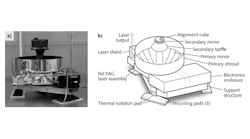NASA Goddard delivers OVIRS spectrometer to optimize sample collection on asteroid Bennu
A spectrometer that will explore the surface of a primitive asteroid in search of water and organic materials has arrived at Lockheed Martin for installation onto NASA’s Origins, Spectral Interpretation, Resource Identification and Security-Regolith Explorer, or OSIRIS-REx. The The OSIRIS-REx Visible and Infrared Spectrometer, or OVIRS, instrument measures visible and near infrared light from the asteroid Bennu that can be used to identify water and organic materials. NASA's Goddard Space Flight Center (Greenbelt, MD) built the instrument.
"The delivery of OVIRS to the spacecraft means the mission now has the capability to measure the minerals and chemicals at the sample site on Bennu," said Dante Lauretta, principal investigator for OSIRIS-REx at the University of Arizona (UA; Tucson, AZ). "I greatly appreciate the hard work and innovation the OVIRS team demonstrated during the creation of this instrument."
OVIRS, a point spectrometer, will split the light from Bennu into its component wavelengths, similar to a prism that splits sunlight into a rainbow, but over a much broader range of wavelengths. Different chemicals have unique spectral signatures by absorbing sunlight and can be identified in the reflected spectrum. The spectra provided by the instrument will help guide sample site selection on the asteroid.
"Through the team's efforts, OVIRS has become a remarkably capable instrument, which we expect to return exciting science from the asteroid Bennu," said Dennis Reuter, OVIRS instrument lead from Goddard.
After thorough testing with the spacecraft on the ground, the instrument will be powered on for check-out shortly after launch, with first science data collected during the Earth gravity assist in September 2017. OSIRIS-Rex is the first U.S. mission to return samples from an asteroid to Earth for study. The mission is scheduled for launch in September 2016. It will reach its asteroid target in 2018 and return a sample to Earth in 2023.
The spacecraft will travel to Bennu, a near-Earth asteroid, and bring back to Earth a sample of at least 2.1 ounces for study. The mission will help scientists investigate the composition of the very early solar system and the source of organic materials and water that made their way to Earth, and improve understanding of asteroids that could impact our planet.
"The OVIRS team has met all of their technical requirements," said Mike Donnelly, OSIRIS-REx project manager at Goddard Space Flight Center. "This is another step in completing the spacecraft and sending it on its way to rendezvous with the asteroid Bennu."
NASA's Goddard Space Flight Center provides overall mission management, systems engineering and safety and mission assurance for OSIRIS-REx. Lauretta is the mission's principal investigator at the UA. Lockheed Martin Space Systems (Denver, CO) is building the spacecraft. OSIRIS-REx is the third mission in NASA's New Frontiers Program. NASA's Marshall Space Flight Center (Huntsville, AL) manages New Frontiers for the agency's Science Mission Directorate in Washington, D.C.
SOURCE: University of Arizona; http://uanews.org/story/second-instrument-delivered-for-osiris-rex-mission

Gail Overton | Senior Editor (2004-2020)
Gail has more than 30 years of engineering, marketing, product management, and editorial experience in the photonics and optical communications industry. Before joining the staff at Laser Focus World in 2004, she held many product management and product marketing roles in the fiber-optics industry, most notably at Hughes (El Segundo, CA), GTE Labs (Waltham, MA), Corning (Corning, NY), Photon Kinetics (Beaverton, OR), and Newport Corporation (Irvine, CA). During her marketing career, Gail published articles in WDM Solutions and Sensors magazine and traveled internationally to conduct product and sales training. Gail received her BS degree in physics, with an emphasis in optics, from San Diego State University in San Diego, CA in May 1986.

